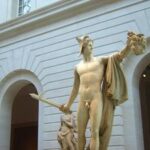In the old Celtic myths the British Isles, and specifically Ireland, were setted by a group of ancient gods called the Tuatha De Danann. These gods, who were all children of the goddess Danu, were a learned tribe who had mastered war, science and magic. They came to Ireland and drove out the giants and the Fomorians, and eventually ruled the island. In time men came, and eventually drove out the gods who either went back to their old home or walked into the world next door beneath the mounds that cover Ireland. However, the legends of these gods was carried on by the ancient druids and the bards who told their tales. One goddess in particular was so cherished and loved that she is still remembered today even though the old pagan faiths were suppressed and mostly lost. Her name is Brigid.
Brigid was one of the major goddesses worshipped by the old Celts. She was born at dawn, and the light of her was associated with poetry, health, strength, knowledge and enlightenment. Brigid was often the representation of the maiden of the triple goddess, and many may view her as the opposite side of the same coin that contains the Morrigan. Peaceful and always desiring to help and heal Brigid was the daughter of the Good God Dagda, who was the first king of the Tuatha De Danann.
Beautiful almost beyong compare, Brigid was the goddess of hearth and home. So it seemed destined that she would wed, and she was given as a bride to the chief of a warring nation in hopes of making peace. She had three sons with her husband, and she taught the oldest of her sons the art of metal smithing. Her son was killed in battle when he slew the enemy’s smith in an attempt to deprive them of steel, and Brigid fell down and wept so loudly that her grief was said to be heard throughout Ireland. This sorrow struck the warriors so firmly that they forged peace to help placate the goddess, and it was the first creation of the Irish tradition called keening. It may also have been a partial inspiration for the legend of the banshee, who heralded death.
Because of how popular she was with the people, worshiped by everyone from pregnant women to scholars to farmers, Brigid was made a saint rather than a demon. It was the common practice of Christian missionaries, like the famous Saint Patrick, to take the local religion of a culture and change it around to mirror Christianity. From keeping the feast days the same to explaining the old gods in terms of saints and demons, early Christians knew that gently easing a people into a faith was much simpler than trying to instill a whole new set of beliefs and religious practices. Unlike many of the other gods, Brigid was made a saint who brought purity, faith and Jesus Christ to people who suffered. Since she alread had the curing of lepers in her myths, as she was associated with healing springs throughout Ireland, it wasn’t a big stretch.
Today Brigid is regarded as a saint by Catholics, and many of her ancient fires that were once tended by pagan peoples are tended by nuns and monasteries. There are a number of new age worshipers that feel more comfortable with the goddess’s old form though, particularly Celtic Wiccans and neo druids who are attempting to re-capture the old faith of the Celts. Though the associations may change, many of her legends and almost all of her associations remain the same.
“In Celtic Mythology, Who is Brigid?” by S. E. Smith at Wise Geek
“Brigid, Celtic Goddess of Fire,” by Anonymous at Goddess Gift
“Brigid,” by C. J. Chow at Brigid’s Flame




